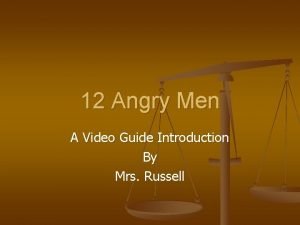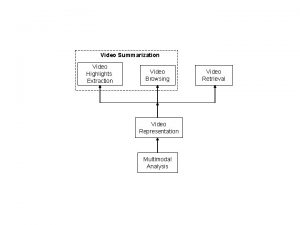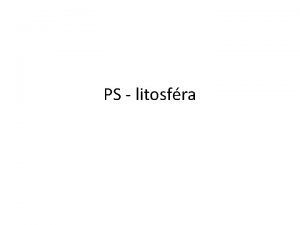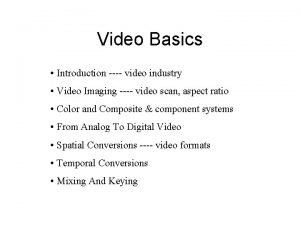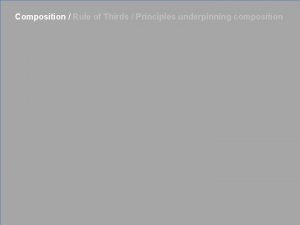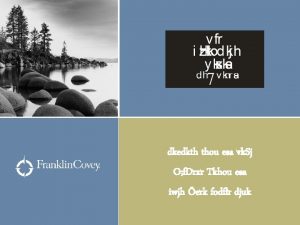Video Composition Your guide to getting the most



















- Slides: 19

Video Composition Your guide to getting the most from your camera.

Defining Composition • Composition can be defined as the orderly arrangement of elements in a scene which, when taken as a whole, conveys intent and meaning.

Composition Guidelines #1…Clearly establish your objectives • Good writers, producers, directors, and editors know the purpose of each and every shot. So, before you record any shot, have two things clearly established in your mind: – the specific reason for the shot – the purpose of the shot within the overall production

Composition Guidelines • The speed at which ideas are presented in productions has increased dramatically in recent years. • Slow=boring • Too fast=hard to follow • If in doubt, leave it out

Composition Guidelines • Viewers assume that every shot, gesture, and word of dialogue in a production is there to further the central idea. • Each shot you use should contribute to the story or idea being conveyed.

Composition Guidelines #2 … Have unity • When the elements of a shot combine to support a basic visual statement, the shot is said to have unity. • The concept of unity applies to such things as lighting, color, wardrobes, sets, and settings.

Composition Guidelines #3 …Compose scenes around a single center of interest. • Think of each shot as a statement • The viewer has a limited time to understand the content and meaning of a shot. If some basic meaning isn't obvious before the shot is changed, the viewer will miss the point of the scene.

Composition Guidelines • Techniques that can help: – Selective Focus – Using light for emphasis – Shifting centre of interest by movement in scene

Composition Guidelines #4 …Observe proper subject placement. • Lead room • Look room • Rule of Thirds • Horizontal and vertical eyelines

Composition Guidelines #5 …Tonal and Mass Balance – Lightness or darkness can suggest weight – Objects in a room can appear heavy – Different camera angle or panning can create a better balance of “Perceptual weight” Which one looks heavier? How would you room look if all the furniture was piled on one side?

Composition Guidelines #6 …Use a combination of scenic elements to create meaning. • Pay careful attention to the specific elements included in a scene. • Elements in a shot may be bold and obvious, or they may be subtly designed to suggest almost subconscious meaning.

Composition Guidelines #7 …Make use of lines • The boundaries of objects in a shot normally consist of lines: straight, curved, vertical, horizontal, and diagonal. • Our eyes tend to travel along these lines as they move from one part of the frame to another.

Composition Guidelines #8 …Frame the central subject matter

Composition Guidelines #9 …Use the effect of visual perspective to enhance or support the scene's basic idea.

Composition Guidelines #10 …Convey Meaning Through Colors and Tones • Bright colors add energy to composition • Eyes initially tend to be drawn to the "warmer" areas of a picture.

Composition Guidelines #11 … Avoid Mergers – tonal mergers – dimensional mergers – border mergers How could you have solved these mistakes?

Composition Guidelines #12 …Control the number of prime objects in the scene • An odd-number of primary objects provides stronger composition than an even number.

Composition Guidelines #13 … Balance Complexity and Order • Complexity without order produces confusion • Order without complexity produces boredom.

Composition Guidelines #14 …Movement and Meaning • Utilize the meaning suggested in the direction of movement • Where action comes from and moves to is significant • Left-to-right movement is generally more engaging than right-to-left movement
 The secret to getting ahead is getting started
The secret to getting ahead is getting started 3.05 getting the most for your money
3.05 getting the most for your money Managing your own business
Managing your own business Yandex ru video search text video
Yandex ru video search text video Yahoo search video
Yahoo search video Searchyahoo
Searchyahoo Digital media primer
Digital media primer Your most unhappy customers are your greatest
Your most unhappy customers are your greatest 12 angry men video questions
12 angry men video questions Give us your hungry your tired your poor
Give us your hungry your tired your poor Hát kết hợp bộ gõ cơ thể
Hát kết hợp bộ gõ cơ thể Ng-html
Ng-html Bổ thể
Bổ thể Tỉ lệ cơ thể trẻ em
Tỉ lệ cơ thể trẻ em Chó sói
Chó sói Tư thế worm breton là gì
Tư thế worm breton là gì Chúa yêu trần thế alleluia
Chúa yêu trần thế alleluia Các môn thể thao bắt đầu bằng tiếng đua
Các môn thể thao bắt đầu bằng tiếng đua Thế nào là hệ số cao nhất
Thế nào là hệ số cao nhất Các châu lục và đại dương trên thế giới
Các châu lục và đại dương trên thế giới








